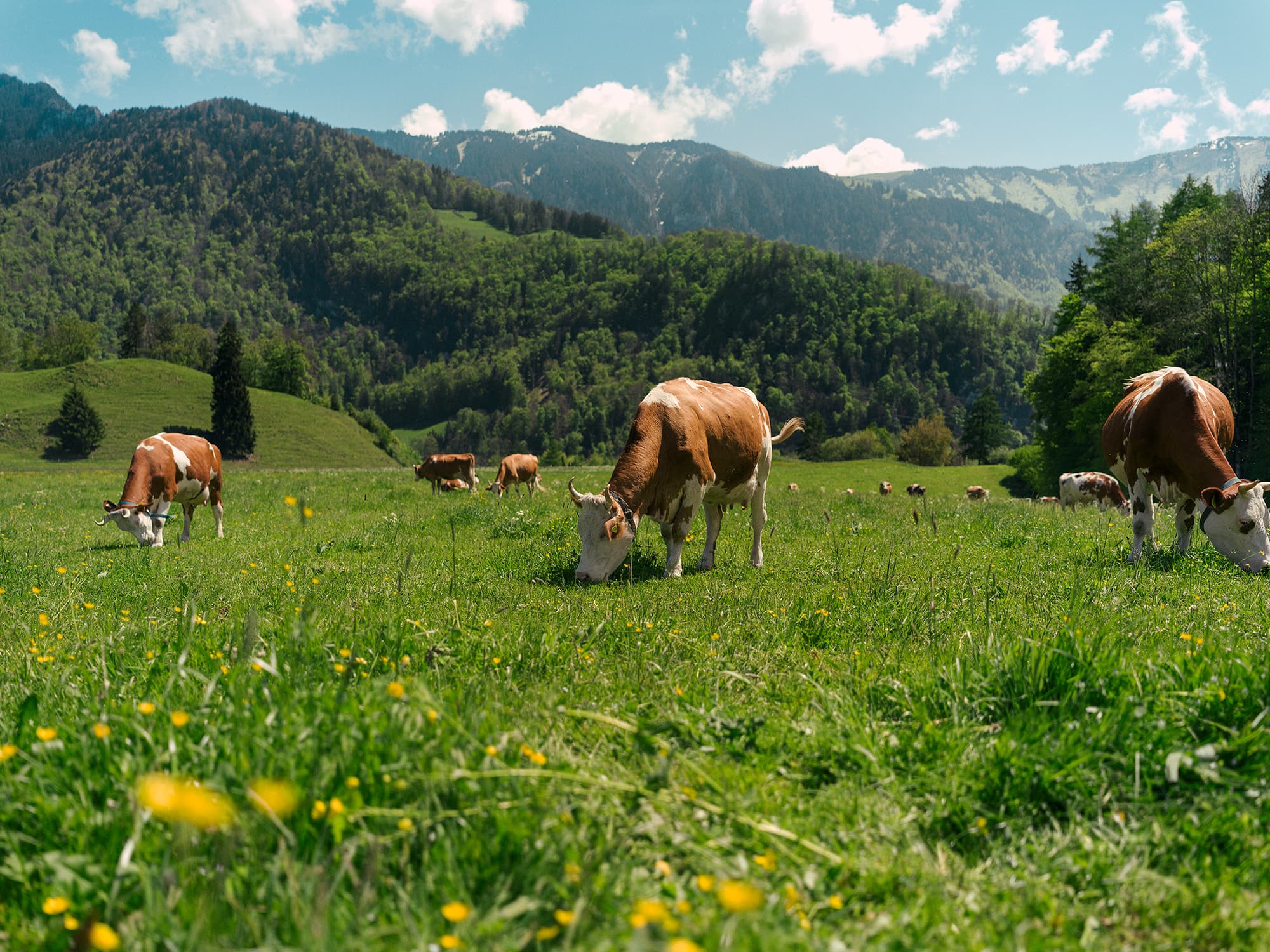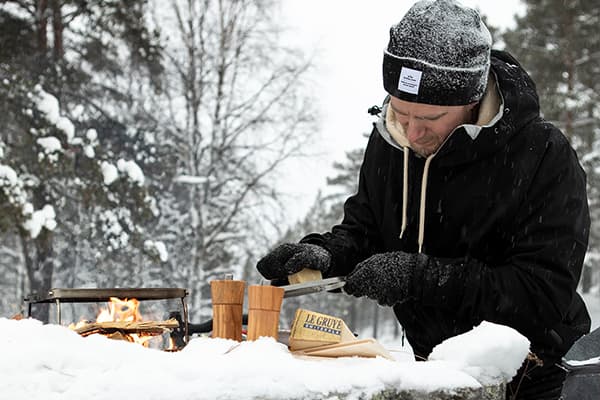Cheese from Ancient Times
The art of cheese-making was known as early as around 5000 B.C. in Mesopotamia, from where it spread to the Mediterranean region. Archaeological excavations, such as the friezes on temple columns in Mesopotamia, show that the production of sour cream cheese was part of early food culture. In ancient Greece, goat cheese was made and even offered as sacrifices to the gods, and during the Roman Empire, cheese production advanced significantly. The Romans brought new methods and tools, and cheese began to be made from various types of milk, such as cow, sheep, and goat milk, spreading this knowledge far and wide.
Helvetia – The Cradle of Cheeses in the Alps
The region of Switzerland, then known as Helvetia, was already a center of cheese production before the Roman Empire (15 B.C. – 400 A.D.). Archaeological finds and historical documents indicate that mountain shepherds made cheese during the summers in the Alpine meadows, where their cattle grazed. The Roman historian and naturalist Pliny the Elder describes the cheese made by the Helvetians in his work Naturalis Historia (ca. 77 A.D.) under the name “Caseus Helveticus.” He mentions the raw materials and production methods, which relied on local cattle farming and the conditions of the mountains.
The Romans developed cattle farming and introduced new crops and preservation techniques that improved milk quality and cheese shelf life. These innovations merged with local traditions, laying the foundation for the development of Swiss cheese culture.
Expanding Markets – Roads and Trade
The Romans built roads that facilitated trade and the transportation of cheese to cities and markets. Cheese was highly valued, especially among soldiers and travelers, due to its excellent shelf life. This laid the groundwork for the commercial spread of cheese, and Swiss cheeses began to gain a foothold in broader regions. Later, railroads played a significant role in transporting cheese from Switzerland to other markets.

Self-Sufficiency in the Middle Ages
Until the late Middle Ages, the Swiss were almost entirely self-sufficient. Settlements in the Alpine valleys were concentrated in areas suitable for grain cultivation, but cattle for milk production were primarily raised at the foothills of the mountains. Milked milk was processed into more durable forms, such as butter, curd, whey cheese, and cheese. As transportation and routes developed, more people settled in remote mountain valleys, strengthening cheese-making traditions.
Gruyères and the Birth of Le Gruyère AOP
In western Switzerland, in the canton of Fribourg, the municipality of Gruyères is the birthplace of Le Gruyère cheese. The history of the town dates back to the 12th century, and in 1270, it received town rights, developing into an important administrative and commercial center. The first written records of Le Gruyère cheese date back to 1115, and its name originates from this very town.
Cheese began to be produced systematically in the region’s monasteries and farms. During the Middle Ages, monasteries, such as the Benedictine monastery of Brouillon, served as key centers for cheese production. They had their own cattle and fresh milk, and monks developed special recipes, such as Le Gruyère, known for its robust flavor and firm texture. The clergy’s literacy helped preserve and pass down these recipes from generation to generation, ensuring the continuity of the tradition.

The Swiss Confederation and Cheese Trade
The founding of the Swiss Confederation in 1291 (Uri, Schwyz, and Nidwalden) and its growth until the 16th century created a larger market area that promoted the trade of cheese and other agricultural products. Cooperation between cantons enabled the exchange of cheese-making methods, leading to the development of new cheese types, such as Emmental and Le Gruyère. By the 16th century, the quality of Le Gruyère cheese improved significantly due to advanced production methods, and it began to gain recognition not only locally but also on wider markets.
The Industrial Revolution and Railroads
In the mid-19th century, the construction of railroads revolutionized Switzerland’s cheese exports. The Industrial Revolution improved cheese transportation and storage possibilities, enabled the production of larger batches, and made exports economically viable. Railroads sped up the transportation of cheese across Europe, and Swiss cheeses, particularly Le Gruyère, began to gain international acclaim for their quality and traditional production methods. Switzerland’s central location in the heart of Europe made it a natural trading hub, and producers emphasized the origin and craftsmanship of their cheeses in branding.

Le Gruyère AOP – A Protected Heritage
Le Gruyère cheese received Swiss AOP (Appellation d’Origine Protégée) protection in 2001, which the European Union recognized in 2011. This protected designation of origin ensures that only cheese made in the cantons of Fribourg, Vaud, Neuchâtel, Jura, and a few municipalities in the canton of Bern, using traditional methods and raw milk, can bear the name Le Gruyère AOP. The designation safeguards the cheese’s quality, production process, and local origin, which have developed over centuries. The AOP label is also economically important for local producers, as it protects the product from competition and attracts tourists interested in the region’s food culture.

The Versatility of Le Gruyère AOP
Le Gruyère AOP is a versatile culinary treasure: it’s perfect for cheese platters, melts beautifully in cooking (e.g., in fondue or baking), and adds depth to salads and pastas. The traditional fondue, combining Le Gruyère AOP with milder Vacherin Fribourgeois AOP (known as moitié-moitié), is a wintertime delight, enjoyed with bread cubes, vegetables, and boiled potatoes. Raclette, another Swiss classic, originated when shepherds melted cheese over a fire and scraped the melted cheese onto bread—its name derives from the French verb racler (to scrape).
Gruyères – A Living Tourist Destination
The town of Gruyères and its iconic Château de Gruyères castle, built in the 12th century, are key attractions for visitors. Perched on a hill, the castle offers breathtaking views of the Gruyères valley and Prealps. The Maison de Gruyère visitor center provides guided tours, exploring the cheese-making process from milk collection to maturation. Open year-round, the cheesery also hosts special events, such as cheese markets.
In Conclusion – Cheese at the Heart of Culture
Swiss cheeses, especially Le Gruyère AOP, are much more than food: they represent Swiss quality of life, craftsmanship, and community. They are an integral part of the country’s culture and history, with their story continuing to unfold in the canton of Fribourg, where traditions remain tangible and alive.










